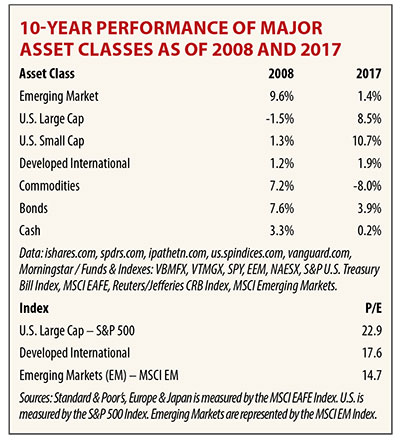Below is a look at 10-year annual returns of major asset classes in 2008 and 2017. What’s notable is how an asset class deemed “today’s favorite” becomes a “dawg” a handful of years later. For example, in 2008 emerging market stocks led the pack with a 9.6 percent annualized return only to severely underperform thereafter, thus dropping to near the bottom of the pack with a 1.4 percent (10-year annualized) return in 2017.
U.S. large-cap stocks, laggards in 2008 with a negative 1.5 percent return, have had a stellar run with a climactic finish in 2017 (due in part to the Trump administration’s tax cuts) placing them near the top of the charts with a 8.5 percent annualized return.
 The message being, a smart asset allocation decision often involves owning out of favor asset classes as opposed to only today’s winners, so portfolios can better diversify the sources of return.
The message being, a smart asset allocation decision often involves owning out of favor asset classes as opposed to only today’s winners, so portfolios can better diversify the sources of return.
Keep in mind, strong performance results in higher prices and richer valuations, while the reverse holds true. Using a P/E ratio based on trailing 12-month earnings, emerging markets look relatively attractive to developed markets in the U.S., Europe and Japan.
Today’s favorites will likely become tomorrow’s laggards, while assets that show strong relative value and/or have underperformed for an extended period, such as emerging markets and broad commodities, may flip the charts and be leaders of the pack.
Disclosures: The information presented herein has been obtained or derived by sources believed to be accurate and reliable. This document has been provided to you solely for information purposes and does not constitute an offer or solicitation of an offer, or any advice or recommendation, to purchases any securities or other financial instruments, and may not be construed as such. The investment strategy, views, and themes described herein may not be suitable for all investors. All opinions expressed are those of the author and are current only as of the date appearing on this material. There is risk of substantial loss associated with trading equity, currency, interest rate and commodity-related futures, options, derivatives and other financial instruments. Before trading, investors should carefully consider their whole financial position and tolerance for risk, and determine if the proposed trading style and investment strategy is appropriate. Advisory services offered through KMS Financial Services, Inc. The performance results contained herein do not reflect the deduction of transaction costs and other fees that may be associated with investing, such as brokerage or advisory fees. Past performance is not an indication of future results, and should not be construed as such.
Robert Okada, CFA, is senior investment strategist at Johnson Bixby & Associates, LLC. Before joining JBA in 2015, Robert Okada was principal and portfolio manager at the Okada Group, where he managed multi-asset class portfolios for individual investors. In his three decades in the industry, he’s amassed an impressive resume: He’s managed client portfolios at O2 Capital Management, served as vice president in Smith Barney’s mortgage products group and was a fixed income specialist for Salomon Brothers.


